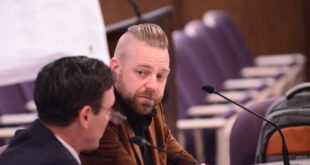
A Booker Street congregation that has been trying to get a new church approved for more than seven years will have to wait a little bit longer.
The Planning Board on July 10 made it clear that it had issues with the application filed by the Macedonia Church of God in Christ International. The church wants to raze its current 76-year-old building and construct a 4,880-square-foot structure.
The application seeks 10 bulk variances, for lot size, yard setbacks, and impervious surface coverage, among others.
The application’s main stumbling blocks were the size of the building and the necessary parking. With a proposed 303 seats in the sanctuary, the church would need 101 parking spaces, according to Township Principal Planner Mark Healey.
The church proposed 38 parking spaces on site, and has parking agreements with a branch of PNC Bank and RPM Development, which is building apartments in the neighborhood, said Peter Lanfrit, the church’s attorney.
The application calls for 303 seats in the sanctuary, even though the church does not yet attract more than around 50 congregants for Sunday worship.
Severina Edward, a church Trustee, told the Board that she counted the number of congregants attending church during November, 2023, and found that the number ranged from 26 people to 54 people.
That led some Board members to question why the church was looking for a structure with 303 seats.
The answer, the Board was told, is that the church expects future growth from the neighborhood redevelopment, as well as the redevelopment of nearby Hamilton Street.
“On any given Sunday, the numbers can increase,” Edward said. “In order to accommodate not just the numbers we have, but the growth that we are expecting, we would like to go a little bigger.”
The church’s anticipated growth “is, to me, hard to believe just because you’ve e been at this for seven years,” Orsini said. “If you haven’t gown that much in seven years, how do we as a Board believe that you would grow that much in the future?”
“Hope is not a strategy,” he said. “You’re asking us to assume that there’s going to be a significant draw to this church.”
Larry C. Johnson, the project’s architect, told the Board that he has designed churches across the state, and he has seen increases in congregations once the new buildings are constructed.
“It could happen, I’ve seen it happen,” he said. “I’ve been doing this since 1964. It’s not just a building, it’s an edifice.”
Jay Troutman, the project’s traffic engineer, tried to convince the Board that there would be enough parking spots provided with those on-site, the agreements with PNC and RPM, and street parking, but the Board wasn’t convinced.
Orsini noted that the Board could not enforce the parking agreements if PNC or RPM cancelled them.
“In the years I’ve lived in this town, there have been five banks there,” Board member Robert Thomas said. “I’m not saying that it can’t work, but it is a concern.”
Thomas suggested that the church reduce the number of seats by 100.
“You don’t have the need for them at the moment,” he said. “If you find you do have the need for them, then you come back and demonstrate how the site is working. If you lose 100 seats, you’re parking requirement will be reduced by enough spaces that the on-site parking and off-site parking, you practically have it covered.”
After a short recess, Lanfrit told the Board that his client would like to pursue Thomas’s suggestion, as well as looking at reducing the size of the building so so many variances would not be needed.
The application is next scheduled to be heard at the Board’s October 16th meeting.
 The Franklin Reporter & Advocate Eight Villages, One Community
The Franklin Reporter & Advocate Eight Villages, One Community

